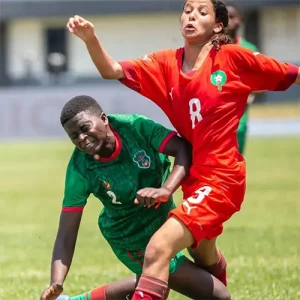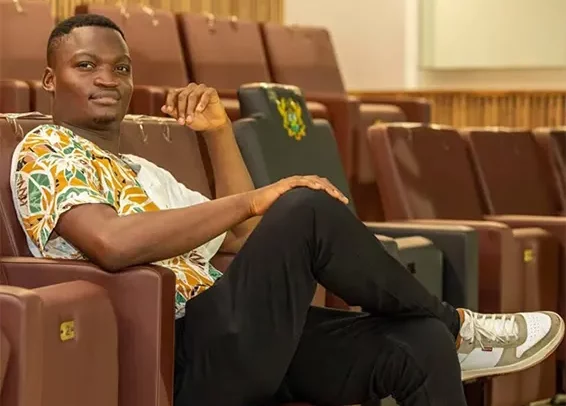Elisha Bruce
“In 2013, I registered to sit for the Basic Education Certificate Examination (BECE), but suddenly, the headmistress of my school informed my parents that I could not join my classmates in writing the exams due to my condition. She feared that my potential failure would tarnish the school’s reputation,” Elisha recalls.
Elisha Bruce Robertson born on June 18, 1997, is the second of four siblings to Apostle Daniel Dornu Bruce Robertson and Doris Bruce Robertson (Nana-Aku Anaafi I).
His mother, Doris, vividly remembers the struggles they faced. “My child was born healthy, but at the age of two, he found it difficult to take his first steps. It was a troubling moment for me as a mother. We sought help from herbal practitioners, but the medication yielded no extraordinary results,” she said.
At six years old, Elisha was diagnosis with Arachoid Cyst, he underwent his first surgery, marking the beginning of a long medical journey that would include five surgeries aimed at stabilising his condition.
An arachnoid cyst is a type of fluid-filled sac that forms between the brain or spinal cord and the arachnoid membrane, one of the three layers of protective tissue surrounding these areas.
Despite the love and support from family and friends, Elisha faced harsh treatment from peers at school. The stigma surrounding his condition often led to isolation, compelling his parents to remain actively involved in his daily activities.
The most painful chapter of his childhood came when he was denied the opportunity to sit for the BECE alongside his peers. After being enrolled in another school, he had to wait an entire year to join the 2014 cohort for the examination. However, adversity did not deter Elisha’s spirit.
With a passion for arts and creativity, he gained admission to the Okuapeman Senior High School, where he pursued Visual Arts. “My senior high school experience was far better than my junior high school. I felt welcomed and at home,” he shared.
Although he faced disciplinary actions at times, some teachers chose to overlook his missteps, fostering an environment of acceptance. Upon completing high school, Elisha ventured into T-shirt printing, creating designs for school organizations and corporate bodies. His entrepreneurial spirit flourished as he navigated this new venture. After two attempts at remedying his exams scores, he gained admission to the University of Education, Winneba to study music.
After his admission, Elisha enrolled at the University of Ghana to study a short course in 3D Animation.
It was during his time at Winneba that Elisha discovered a passion for philanthropy. As a gifted drummer, he took it upon himself to train others interested in learning the instrument, earning admiration from his peers. “At Winneba, we mobilized resources with the help of my friends to support those in need in our community,” he asserted.
Elisha’s journey into photography began when he sent his laptop for repairs and stumbled upon a Photoshop application on a friend’s device. Intrigued by its capabilities, he dove into learning the software, which ultimately fueled his curiosity and passion for capturing moments through photography.
While exploring the mobile app during vacation, he chanced upon its editing features and was hooked. After taking a few pictures with a friend’s camera and editing them using the app, Elisha’s interest in photography grew.
“Low and behold, a lot of people loved the pictures,” he revealed, “thereby increasing my interest in photography.”

One of Elisha’s sport photograph
After completing his four-year course, Elisha was posted to the National Sports Authority (NSA) Public Relations, where his expertise in photography came to the fore. His love for sports, infused with his passion for photography, led him to specialize in sports photography. Courtesy his father, Elisha received a modern canon 6d camera to enhance his craft.
Within a year of working with the authority, Elisha took memorable pictures that captured unforgettable moments on the pitch. His talents were evident at the All-African Games, where his photographs went viral. However, few people knew the story behind the lens.
Elisha’s journey has not been without its challenges. Despite facing unique obstacles, he has persevered, using his camera to tell stories that inspire and captivate. “With my condition, I had to go through the mammoth crowd at the stadium to station myself and get the right angles,” he recounted. “I encountered many people weirdly looking at me, but I had to disregard it and pursue my purpose.”
Neurosurgeon at the Korle Bu Teaching Hospital, Dr. Harry Akoto, speaking about the condition said a shunt is a medical device used to treat arachnoid cysts by draining excess fluid and relieving pressure.
He said the shunt ranges from an Indian-made device costs around $1,000, American-made device with a single pressure valve costs around $1,000 and high-end device with a variable pressure valve costs around $3,000.
He indicated that the high cost of the shunt is a significant barrier for many patients, especially in low-income settings, saying, “the surgery itself is relatively inexpensive, but the cost of the device can be prohibitive. There is a need for philanthropists and NGO to come on board to help cover the cost.”
By Prince Fiifi Yorke


